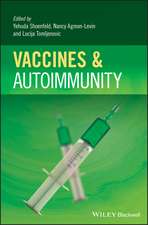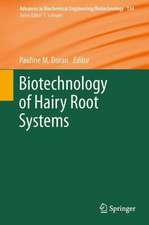Activating and Inhibitory Immunoglobulin-like Receptors
Editat de M. D. Cooper, T. Takai, J.V. Ravetchen Limba Engleză Paperback – 14 noi 2012
| Toate formatele și edițiile | Preț | Express |
|---|---|---|
| Paperback (1) | 1189.22 lei 6-8 săpt. | |
| Springer – 14 noi 2012 | 1189.22 lei 6-8 săpt. | |
| Hardback (1) | 1200.44 lei 6-8 săpt. | |
| Springer – 30 apr 2001 | 1200.44 lei 6-8 săpt. |
Preț: 1189.22 lei
Preț vechi: 1450.27 lei
-18% Nou
Puncte Express: 1784
Preț estimativ în valută:
227.66€ • 234.14$ • 188.87£
227.66€ • 234.14$ • 188.87£
Carte tipărită la comandă
Livrare economică 20 februarie-06 martie
Preluare comenzi: 021 569.72.76
Specificații
ISBN-13: 9784431679592
ISBN-10: 4431679596
Pagini: 260
Ilustrații: X, 246 p.
Dimensiuni: 155 x 235 x 14 mm
Greutate: 0.37 kg
Ediția:Softcover reprint of the original 1st ed. 2001
Editura: Springer
Colecția Springer
Locul publicării:Tokyo, Japan
ISBN-10: 4431679596
Pagini: 260
Ilustrații: X, 246 p.
Dimensiuni: 155 x 235 x 14 mm
Greutate: 0.37 kg
Ediția:Softcover reprint of the original 1st ed. 2001
Editura: Springer
Colecția Springer
Locul publicării:Tokyo, Japan
Public țintă
ResearchDescriere
A remarkable spectrum of novel immunoreceptors sharing related immunoglobulin-like domains and signaling potential has been identified in recent years. These receptors have attracted widespread interest because they resemble the TCR, BCR, and FcR complexes in their ability to serve as activating or inhibitory receptors on the cells that bear them. Moreover, they are well positioned to affect both innate and adaptive immunity. The full range of ligands for these new receptor families is still not known, and understanding of their physiological roles is far from complete. This volume is the first attempt to summarize and highlight all known aspects of immunoglobulin-like receptors, providing a topical overview of the roles and characteristic features of the immunoglobulin-like receptors and related molecules in the immune system. Researchers in immunology, molecular biology, cell biology, clinical medicine, and pharmacology will find this book invaluable.
Cuprins
Introduction: Fc Receptors: Activation-inhibition receptor pairing (J. V. Ravetch).-Part A: Gene Structure, Expression, and Evolution: Phylogeny of Paired Ig-like Receptors (G. Dennis Jr., C.-C. Chen, H. Kubagawa, and M. D. Cooper)Genomic organization of the ILT11 gene, a novel member of the Leukocyte Receptor Cluster (LRC) (H. Wende, A. Ziegler, and A. Volz).Regulated expression of non-polymorphic gp49 molecules on mouse natural killer cells (L. L. Wang and W. M. Yokoyama).Regulation of human FcaR gene expression (T. Shimokawa, T. Tsuge, and C. R).-Part B: Structural Features of Receptor Protein: Molecular recognition by Ig-like receptors, KIRs and FcgRs (K. Maenaka, P. A. van der Merwe, D. I. Stuart, P. Sondermann, and E. Y. Jones).Ig modules as discrete structural units to exploit functional and structural aspects of Ig-like receptors (L. Vangelista and O. Burrone).Structural studies on the leukocyte co-stimulatory molecule, B7-1 (S. Ikemizu, E. Y. Jones, D. I. Stuart, and S. J. Davis).ITIM-bearing receptors in platelets (D. C. Snell, J.-M. Pasquet, and S. P. Watson).Identification of Fca/m receptor expressed on B lymphocytes and macrophages (A. Shibuya, K. Shibuya, Y. Shimizu, K. Yotsumoto, and H. Nakauchi).Functional characterization of mouse CD94 by using a novel monoclonal antibody (N.Toyama-Sorimachi, H. Yagita, F. Kitamura, A. Kawasaki, S. Koyasu, and H. Karasuyama).Interaction of human cytomegalovirus glycoproteins with immunoreceptors (D. Cosman, J. Chalupny, M.-L. Hsu, C. Sutherland, J. Mllberg, M. Kubin, N. Fanger, and L. Borges). Function of gp49A in mast cell activation (M. Ono, K. H. Lee, and T. Takai).The Fc receptor family structure based strategies for the development of anti-inflammatory drugs (P. M. Hogarth, M. S. Powell, L. J. Harris, B. Wines, G. Jamieson).-Part C: Signaling Events and Physiological Roles: The mouse gp49 family (H. R. Katz).Regulation of B-cellantigen receptor signaling by CD72 (T. Tsubata, C. Wakabayashi, and T. Adachi).A role for the SH2-containing inositol phosphatase in the biology of natural killer cells and stem cells (T. Ghansah, J. M. Ninos, and W. G. Kerr).SHIP1-mediated negative regulation of cell activation and proliferation by FcgRIIB (M. Daron, P. Bruhns, R. Lesourne, O. Malbec, and W. H. Fridman).The preBCR signaling through Igb regulates locus accessibility for ordered immunoglobulin gene rearrangements (K. Maki, K. Nagata, F. Kitamura, T. Takemori, and H. Karasuyama).Regulation of phospolipase C-g2 and phosphoinositide 3-kinase by adaptor proteins in B cells (T. Kurosaki).Fc receptor signaling during phagocytosis (E. Garca-Garca and C. Rosales).Molecular mechanism of paired immunoglobulin-like receptor B (PIR-B)-mediated inhibitory signal (A. Maeda, A. M. Scharenberg, S. Tsukada, J. B. Bolen, J.-P. Kinet, and T. Kurosaki).IgE stabilizes its high affinity receptor (FceRI) on mast cells in vitro and ex vivo: The mechanism of IgE-mediated FceRI up-regulation and its physiological meaning (S. Kubo, K. Matsuoka, C. Taya, F. Kitamura, H. Yonekawa, and H. Karasuyama).Autoimmune arthritis and Goodpastures syndrome induced in Fcg receptor-deficient mice (T. Takai and A. Nakamura).Receptors involved in human NK cell activation in the process of natural cytotoxicity (L. Moretta, R. Biassoni, C. Bottino, M. C. Mingari, and A. Moretta).The regulation of PD-1/PD-L1 pathway and autoimmune diseases (T. Okazaki, Y. Iwai, H. Nishimura, and T. Honjo).Identification of the functional recognition site on MHC class I for a NK cell lectin-like receptor (N. Matsumoto, M. Mitsuki, K. Tajima, W. M. Yokoyama, and K. Yamamoto).Characterization of Tm1 cells, a NKR+ subset of memory-phenotype CD8+ T cells (N. Anfossi, V. Pascal, S. Ugolini, and E. Vivie).How do killer cell Ig-like receptors inhibit natural killer cells? (E. O. Long, D. N. Burshtyn, C. C. Stebbins, an










